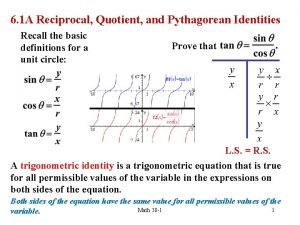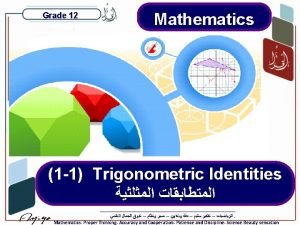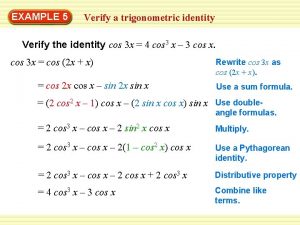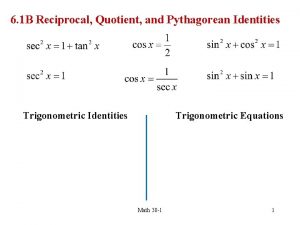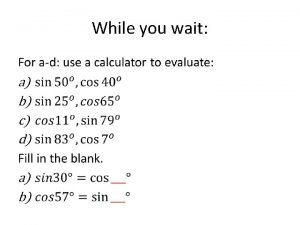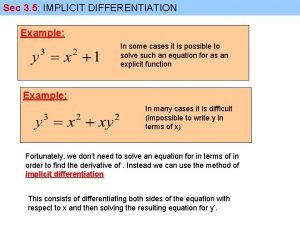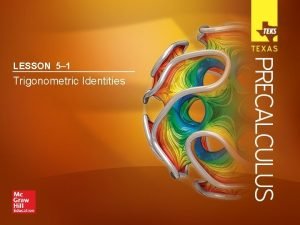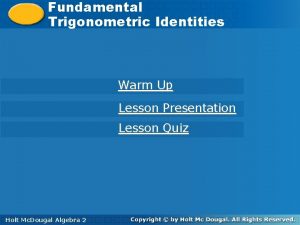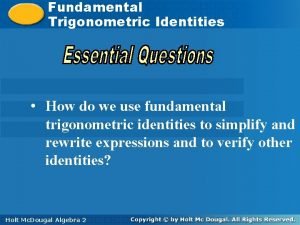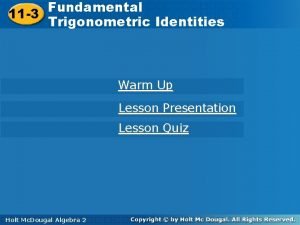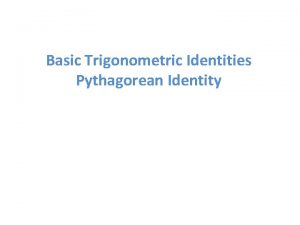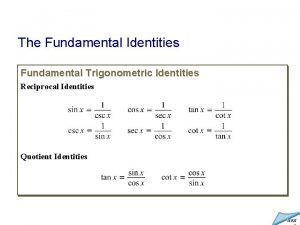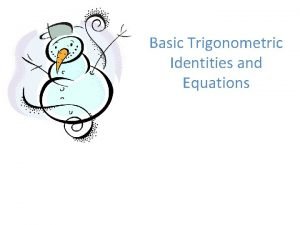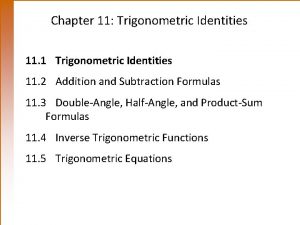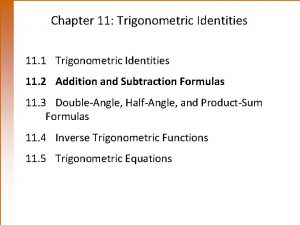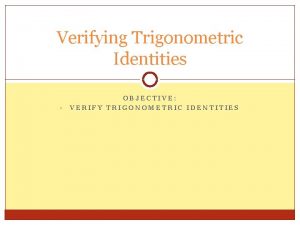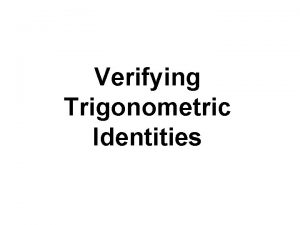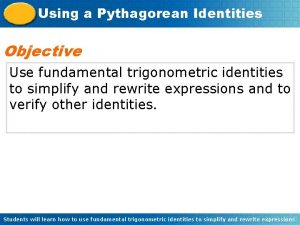Trigonometric identities Pythagorean identity In this section we












- Slides: 12

Trigonometric identities

Pythagorean identity In this section we are going to look at special kinds of equations called identities y B (cos q, sin q) 1 q 0 cos q C sin q A x From the unit circle we found that: cos q = x OC = cos q sin q = y BC = sin q Since it is a right angled triangle we can use Pythagoras theorem and say that (cos q )2+ (sin q )2 = 1 cos 2 q + sin 2 q = 1 This called The Pythagorean identity We can also say that tan q = sin q cos q Another identity

Double angle identity for cosine In the following diagram, we draw the reflection of the angle q in the fourth quadrant. y The length AC = BC = sin q A So, AB = AC + BC = 2 sin q 1 sin q q C We can see that the angle AOB = 2 q O q sin qx The length AB can be found using the 1 cosine rule in the DAOB. B AB 2 = AO 2 + BO 2 – 2(AO)(BO)cos (2 q) AB 2 = 12 + 12 – 2(1)(1)cos (2 q) Now we have two expressions for AB 2 sin q Squaring both sides 4 sin 2 q = 2 - 2 cos (2 q) Rearranging 2 cos (2 q) = 2 - 4 sin 2 q Dividing by 2 cos (2 q) = 1 - 2 sin 2 q This is one identity for the cosine of the double angle

Double angle identity for cosine We are going to use this identity to find more identities for the cosine of the double angle cos (2 q) = 1 - 2 sin 2 q We will use the Pythagorean identity cos 2 q + sin 2 q = 1 Rearranging the identity Substituting in the identity Expanding brackets Simplifying and rearranging sin 2 q = 1 – cos 2 q cos (2 q) = 1 – 2(1 – cos 2 q) cos (2 q) = 1 – 2 + 2 cos 2 q cos (2 q) = 2 cos 2 q – 1 This is another identity for the cosine of the double angle

Double angle identity for cosine We are going to use this last identity to find more identities for the cosine of the double angle cos (2 q) = 2 cos 2 q – 1 We will use the Pythagorean identity cos 2 q + sin 2 q = 1 We can substitute the identity into the identity cos (2 q) = 2 cos 2 q – (cos 2 q + sin 2 q ) Expanding brackets cos (2 q) = 2 cos 2 q – sin 2 q Simplifying cos (2 q) = cos 2 q – sin 2 q This is another identity for the cosine of the double angle

Double angle identity for sine Now we are going to find a double-angle identity for sine We will use the Pythagorean identity cos 2 q + sin 2 q = 1 We can say cos 2 (2 q ) + sin 2 (2 q ) = 1 Rearranging cos 2 (2 q ) = 1 – sin 2 (2 q ) From the double angle identity for cosine Squaring both sides cos (2 q) = 1 - 2 sin 2 q cos 2 (2 q) = (1 - 2 sin 2 q)2 cos 2 (2 q) = 1 - 4 sin 2 q + 4 sin 4 q Equating these equations 1 – sin 2 (2 q ) = 1 – 4 sin 2 q + 4 sin 4 q Simplifying 4 sin 2 q – 4 sin 4 q = sin 2 (2 q ) Factorising 4 sin 2 q (11 – sin 2 q) = sin 2 (2 q ) Substituting from 4 sin 2 q cos 2 q = sin 2 (2 q ) Taking square root of both sides 2 sin q cos q = sin (2 q )

Summary of identities sin q tan q = cos q Pythagorean identity cos 2 q + sin 2 q = 1 Double angle identities for cosine cos (2 q ) = 1 – 2 sin 2 q cos (2 q ) = 2 cos 2 q – 1 cos (2 q ) = cos 2 q – sin 2 q Double angle identity for sine sin (2 q ) = 2 sin q cos q

Using identities Given that sin a , and 0 o < a < 90 o Find the exact values of (a) cos a Solution: Using the Pythagorean identity cos 2 a + sin 2 a = 1 Substituting the value of sine a Rearranging and simplifying Taking square root of both sides

Using identities Given that sin a , and 0 o < a < 90 o Find the exact values of (b) sin (2 a) Solution: Using the double angle identity for sine sin (2 a) = 2 sin a cos a Substituting the value of sin a and cos a sin (2 a) Simplifying sin (2 a)

Using identities Given that sin a , and 0 o < a < 90 o Find the exact values of sin (2 a) (c) cos (2 a) Solution: Using a double angle identity for cosine cos (2 a ) = 1 – 2 sin 2 a Substituting the value of sin a Simplifying

Using identities Given that sin a , and 0 o < a < 90 o Find the exact values of sin (2 a) (d) tan (2 a) Solution: Using identity of tangent sin q tan q = cos q sin (2 a) Changing q by 2 a tan (2 a) = cos (2 a) Substituting sin (2 a) and cos (2 a ) Simplifying tan (2 a) =

Using identities when working with equations Solve the equation sin 2 x = sin x for 0 o x 360 o Do not use GDC Solution: Using the double angle identity for sine sin (2 q ) = 2 sin q cos q Replacing sin 2 x 2(sin x )(cos x ) = sin x Rearranging 2(sin x )(cos x ) – sin x = 0 (sin x )(2 cos x – 1) = 0 Factorising Using the null factor law (sin x ) = 0 or (2 cos x – 1) = 0 If sin x = 0 Then x = 0 o, 180 o, 360 o If 2 cos x – 1 = 0 Then x = 0 o, 60 o, 180 o, 300 o, 360 o So x = 60 o, 300 o
 What is quotient identity
What is quotient identity What is quotient identity
What is quotient identity Identities grade 12
Identities grade 12 Cos 2x formula
Cos 2x formula Reciprocal pythagorean theorem
Reciprocal pythagorean theorem Cos tan sin cot
Cos tan sin cot 7-2 verifying trigonometric identities
7-2 verifying trigonometric identities Differentiation example
Differentiation example 5-2 verifying trigonometric identities
5-2 verifying trigonometric identities What is the quotient identity
What is the quotient identity Fundamental trig identities
Fundamental trig identities Fundamental trigonometric identities
Fundamental trigonometric identities 3 trig identities
3 trig identities
